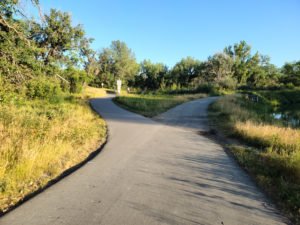
Lane splitting is a very controversial topic. Some claim it’s safer for the motorcycle or bicycle riders to skip the traffic than remain still among the cars, whereas others state that it’s more dangerous. Moreover, the laws regarding lane splitting in the U.S. aren’t unified, so it can actually be quite confusing to try and understand it all. There are states where lane splitting is legal, states where lane splitting is illegal, and states where the law doesn’t really define it. So, what do the laws of Florida say about lane splitting? Is it safe? Are there any benefits? And what should you do if you get involved in a lane-splitting collision?
Have you been involved in an accident caused by a lane-splitting motorcycle in Florida? Then you could receive compensation for it. To learn more about the amount of compensation to which you may be entitled and how to get it, contact The Law Place as soon as possible. Our attorneys have a wealth of experience in car accidents and personal injury, and will be able to help you claim the damages that you deserve. Moreover, most of them have been rated 10.0 by AVVO, which is the highest ranking that an attorney can get at this site.
You can rest assured that your case will be in good hands. So, don’t hesitate and contact us at (941) 444-4444 for a free consultation. Our phone lines are open 24 hours a day, 7 days a week.
What Is Lane Splitting?
Riding between lanes of slow-moving or stopped traffic is known as lane splitting. Dangerous and unpredictable, this practice can lead to serious accidents and injuries on the road. It’s sometimes also called white lining or stripe-riding since the motorcyclist stays predominantly on the white line between the two lanes. This practice typically occurs where traffic is dense, and riding a motorcycle between lanes can save the driver a lot of time or may even be safer for them. Lane splitting is allowed in many European countries as well, but the traffic laws in the U.S. are generally against it. However, the legislation differs from state to state, so motorcyclists should inform themselves before crossing the borders.
Lane splitting can sometimes be confused with similar terms like “lane filtering” or “lane sharing.” However, they aren’t the same. Lane filtering occurs when a motorcycle is picking its way through slow traffic, riding from one lane to another. Lane sharing refers to a situation when two motorcyclists ride in a single lane, either side by side or in a staggered formation.

What Are the Pros and Cons of Lane Splitting?
In 1981, professor Harry Hurt published a report, now known as the Hurt report, implying that the practice of lane splitting slightly reduces the crash frequency and thus improves the safety of motorcycle riders. According to the American Motorcyclist Association, being caught among stop-and-go vehicles is very dangerous for motorcyclists since other motor vehicle drivers may be distracted or inattentive and crash into them from behind. Moreover, lane splitting helps to alleviate traffic congestion by removing motorcycles from it.
On the other hand, riding between lanes can be dangerous since the motorcyclist rides in the door zone where the door of one of the cars might unexpectedly open. Furthermore, in slow-moving traffic, drivers could suddenly try and change lanes, checking only the other lane but not the space in between the two lanes of traffic. Or the motorcyclist could easily get into the blind spot of a car.
There are efforts to legalize lane splitting but also opposing forces fighting against it. However, regardless of their opinion, motorcyclists should always adhere to local rules and regulations. If they don’t, they are putting themselves and others in great danger.
 We’re here to serve you. Our phones are open 24 hours a day.
We’re here to serve you. Our phones are open 24 hours a day. What Does the U.S. Legislation Say About Lane Splitting?
As was already mentioned, U.S. legislation isn’t unified when it comes to the practice of lane splitting. According to the Motorcycle Legal Foundation, U.S. states can be divided into the following categories regarding their stance towards lane splitting:
- States Where Lane Splitting is Specifically Legal – So far, this category includes only California.
- States Where a Modified Version of Lane Splitting Has Been Legalized – In Hawaii, the practice of “shoulder surfing” has been legalized. Shoulder surfing allows motorcyclists to use the freeway shoulder in traffic congestion. However, lane splitting itself will probably never become legal in Hawaii since the roads are generally very narrow there. In Utah, lane splitting is newly legal under certain conditions.
- States Currently Considering Legalizing Lane Splitting – This category includes Washington, Oregon, Maryland, and Connecticut, which have already drafted relevant bills. However, in most of these places, there seems to be no real effort to pass them.
- States Where Lane Splitting Isn’t Mentioned in the Legislation or Isn’t Specifically Illegal – This includes places like Texas, New Mexico, or North Carolina. It’s up to the discretion of each police officer if they let you get away with it.
- States Where Lane Splitting is Illegal – This category includes most of the U.S. states, including Florida.
 We’re Florida’s top litigation team with over 75 years of combined experience
We’re Florida’s top litigation team with over 75 years of combined experience So, Is Lane Splitting Legal in Florida?
No, at the moment, lane splitting is illegal in Florida. Every motorcycle rider crossing the borders of Florida should be aware of it and respect it regardless of their stance towards this matter. Since drivers of other motor vehicles don’t expect anyone riding in between lanes, they can easily overlook a lane-splitting motorcycle. This can lead to a very serious accident causing injuries and even death on both sides. And with lane splitting being illegal in Florida, it will most probably be the lane-splitting motorcyclist who will be found responsible for the crash.
Have you been involved in an accident caused by lane splitting in Florida? Then you may be entitled to compensation. To learn more, contact us today and schedule a free consultation of your case with an experienced car accident lawyer.
 From the initial call to updates on your case status, we are here to get you answers.
From the initial call to updates on your case status, we are here to get you answers. What Are the Most Common Damages for a Lane Splitting Accident in Florida?
In Florida, if you sustain an injury or damage in an accident caused by a lane-splitting vehicle, you deserve to be compensated for it. There are many types of damages you can claim. However, the most common ones include:
- Medical Bills – You deserve to receive full compensation for your medical expenses, for example, the cost of your surgery, rehabilitation, or medication.
- Lost Wages – If you need to take some time off from work to recover from your injuries, you should receive compensation for getting a lower or no salary during that time.
- Property Damage – Apart from causing you an injury, the motorcyclist’s negligence can also cause significant damage to your property. You should receive reimbursement for repair or replacement costs of all your valuables damaged in the accident.
- Pain and Suffering – If you sustained an injury with life-altering consequences, you could claim special compensation for the pain and suffering you endured.
- Wrongful Death – If you have lost a loved one in a lane-splitting accident, you should receive reimbursement of the funeral costs and compensation for your loss of consortium.
As you can see, a car accident doesn’t have to ruin your life and compromise your family income. With a good personal injury attorney by your side, you have a great chance of receiving the compensation you deserve.
Is Lane Splitting Legal in Florida? FAQ
Is lane splitting legal in Florida?
No, lane splitting remains illegal in Florida. Lane splitting refers to the practice of a motorcycle moving between lanes or rows of slowed or stopped traffic, traveling along the dividing lines between lanes. Florida law prohibits this practice, and motorcyclists are expected to adhere to the same rules and regulations as other vehicles on the road.
Why is lane splitting considered dangerous?
Lane splitting is considered dangerous due to the close proximity of vehicles and the reduced space for maneuvering. It can lead to lane splitting motorcycle accidents, especially if other drivers are not expecting a motorcycle to pass them in slowed or stopped traffic. The risk increases due to the limited visibility and reaction time available to both the motorcyclist and the drivers of other vehicles.
What are the consequences if caught lane splitting in Florida?
If caught lane splitting in Florida, a motorcyclist can be cited for a noncriminal traffic infraction. This can result in fines, points on the motorcyclist’s driving record, and potentially higher insurance rates. It’s important for motorcyclists to understand the legal consequences and to refrain from engaging in this practice.
Can lane splitting lead to motorcycle accidents?
Yes, lane splitting can lead to motorcycle accidents. When motorcyclists engage in lane splitting, they may encounter unexpected vehicle movements, such as a car changing lanes or opening a door in slowed traffic, which can result in collisions. Lane splitting accidents often occur because other drivers are not anticipating a motorcycle passing them in close quarters.
What should I do if involved in a lane splitting motorcycle accident?
If you are involved in a lane splitting motorcycle accident, it is crucial to seek medical attention immediately for any injuries. Additionally, document the accident scene, take photographs, and collect contact information from witnesses. Even though lane splitting in Florida is illegal, you may still have legal options available. Contacting a motorcycle accident lawyer can help you navigate the legal complexities and determine if you have a viable motorcycle accident lawsuit.
How can lane splitting impact a motorcycle accident lawsuit?
In a motorcycle accident lawsuit, lane splitting can significantly impact the outcome. If it is determined that lane splitting leads to the accident, the motorcyclist may be found partially or fully at fault due to engaging in an illegal maneuver. However, each case is unique, and factors such as the actions of the other driver and the specific circumstances of the accident will also be considered.
Is it ever legal to lane split in Florida?
Currently, lane splitting in Florida is not legal under any circumstances. Motorcyclists are required to follow the same traffic laws as other vehicles, which include staying within a single lane and not moving between lanes of adjacent lines of stopped or slowed traffic.
Call The Law Place Today
Contact The Law Place today to get the compensation you deserve. Our team of attorneys have more than 75 years of combined experience who have already successfully resolved many cases similar to yours. You can be sure that your case will be in good hands. Moreover, our phone lines are open 24 hours a day, 7 days a week, so that you can reach us at your convenience.
Call (941) 444-4444 today for a free consultation!



